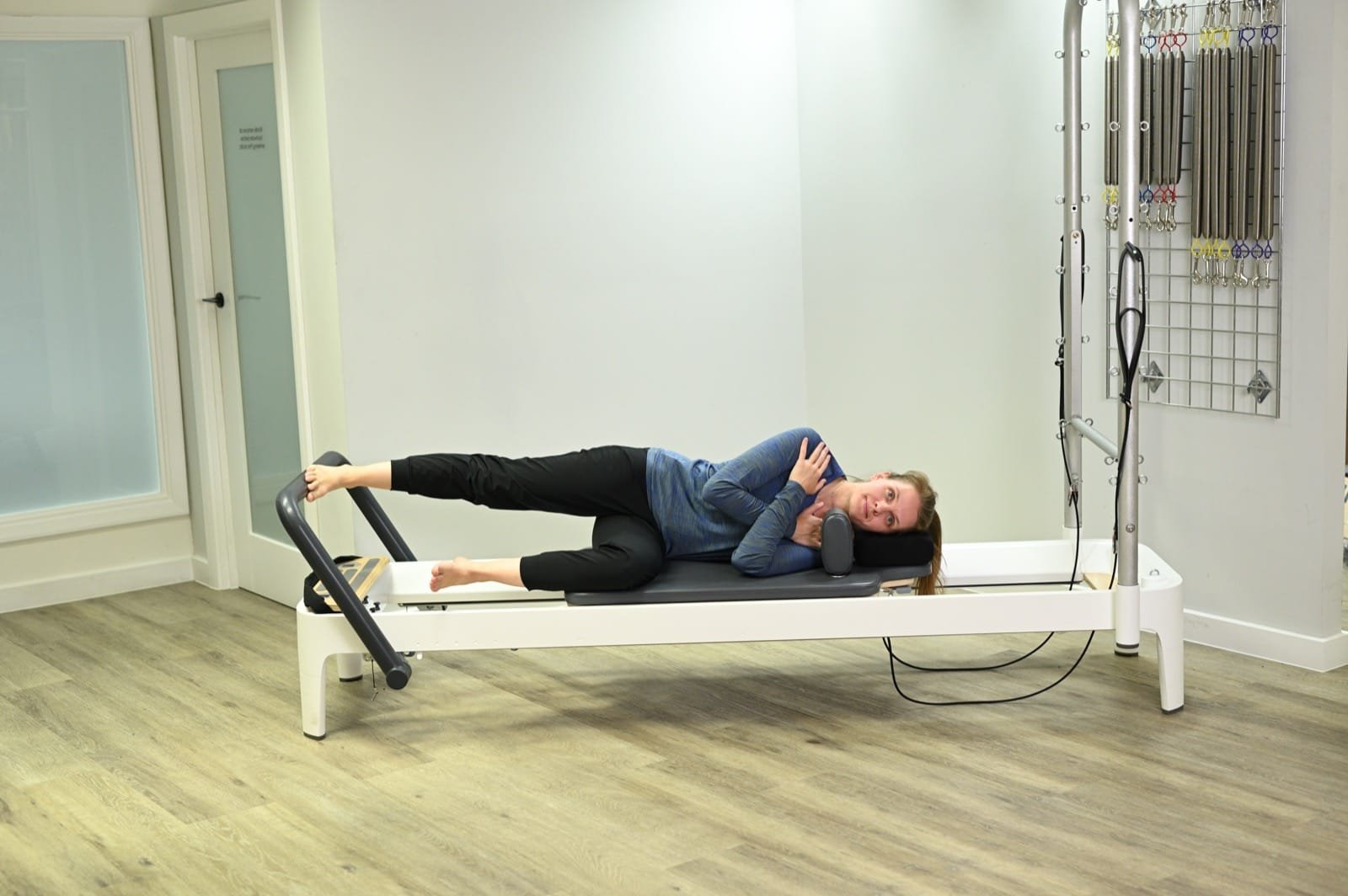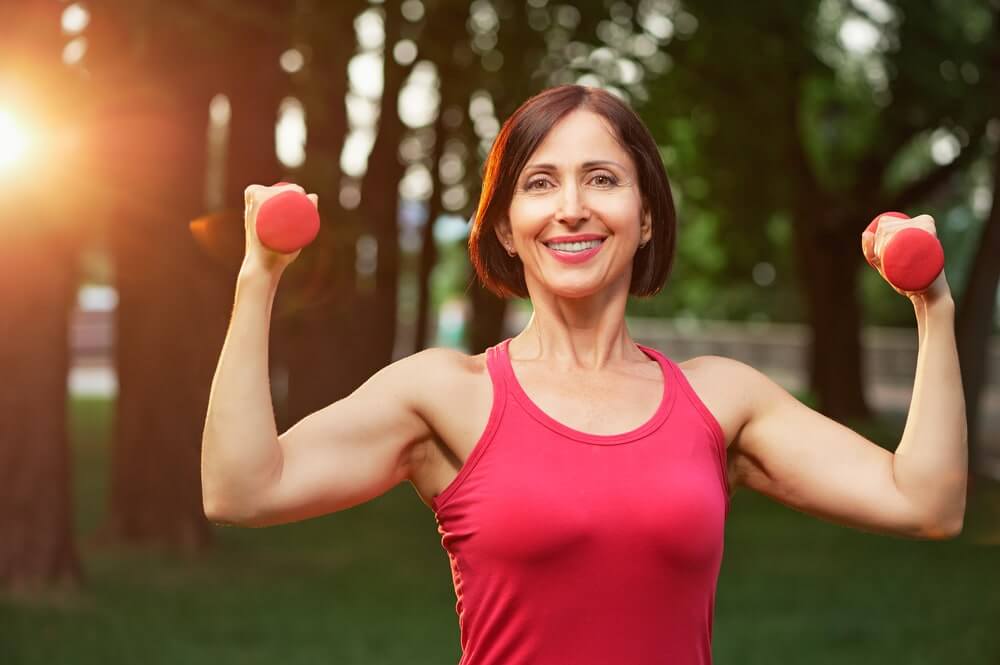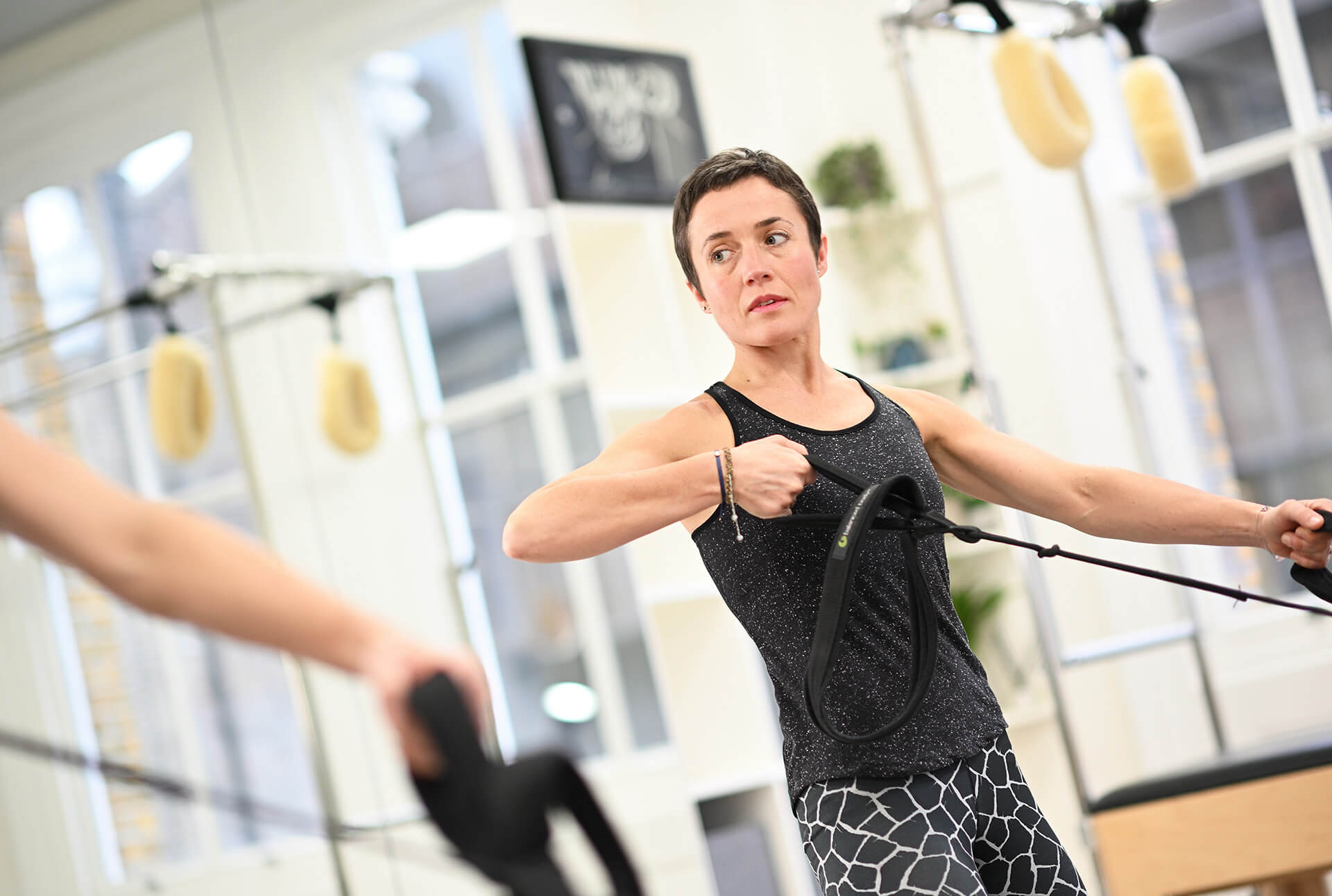Co-Contributors: Lily Holt, Clinical Pilates Instructor
So, you’ve booked your first Pilates session congratulations! But are you wondering what to wear for Pilates? You don’t need any fancy clothes for Pilates, but you do need suitable attire to get the most out of your Pilates experience.
Key Takeaways
- Comfort is essential – Soft, breathable fabrics like cotton, bamboo, or lycra allow you to move freely and stay comfortable during exercises. Avoid bulky seams, zips, or buttons that can dig in when lying down.
- Safety comes first – Loose clothing, jewellery, or accessories can catch on Pilates equipment. Fitted clothing reduces the risk of accidents and distractions during your class.
- Freedom of movement matters – Choose clothes that stretch and move with you. Tight leggings or slim joggers work best for flexibility, while avoiding garments that ride up or expose you in different positions.
- Form-fitting clothes improve feedback – Tighter clothing helps both you and your instructor see how your body moves, making it easier to improve your technique.
- Details complete the look – Pilates is often done in grip socks for stability and hygiene. Secure long hair, wear a soft sports bra for comfort, and pick materials suited to the season for the best overall experience.
Here’s what to wear to your Pilates class: 5 Considerations

1. Comfortable clothes for Pilates
First and foremost, clothes need to be comfortable. It is important to think about the material you are wearing. For example, a stiff or thick fabric such as denim will be much more uncomfortable than something like bamboo, cotton, or lycra. It’s a good idea to think about lumps and bumps when you choose clothes for Pilates.
You will often be lying down for exercises and the last thing you want is a button, zip or a bulky pocket seam digging into you whilst you’re trying to concentrate on your exercises. Soft clothes with a minimum of seams. fasteners or other features are ideal. Also consider extra flaps of material may be undesirable, for example wearing something with a hood – again this may get in the way if you are doing something like a roll down.
2. Safety
Likewise, anything like jewellery or accessories has the potential to be rather uncomfortable. If you lie on a forearm whilst wearing a bracelet or watch or lie flat on your side whilst wearing earrings, they will soon dig in. Accessories may also be a bit of a hazard if you are using equipment as they may get stuck on the mechanical parts of the machinery. Loose sleeves or trouser legs have the potential to get caught in springs or levers on Pilates equipment.
3. Clothes that allow movement for Pilates
When considering what to wear for Pilates, consider that your clothes need to allow for movement. You will be moving your arms and legs through a greater range of movement than usual and so your clothes need to be loose enough or stretchy enough to allow for that increased range.
Loose or tight? Without a doubt, loose fitting clothing will allow you to move well. Some people may prefer looser clothing, especially if they are self-conscious about their body. For men who might be used to baggy joggers or shorts, you can try a combo of medium running shorts over cycling shorts or sports compression tights. If you’re not quite brave enough for that, then a slim fit pair of joggers is a must.
4. Modest Clothing
Do take into consideration though, that the clothing needs to cover you in a variety of positions. Loose tops may ride up if you happen to be doing something where your legs are higher than your head for example. Baggy shorts may also creep up towards the hips if you are performing something like a bridge, so it’s a good idea to wear a tight pair underneath to avoid flashing your underwear!
Men in particular be warned, baggy or very short shorts can show more than you bargained for. Form fitting clothes such as leggings and stretchy tops are popular in Pilates for a good reason – unlike loose clothes they aren’t so likely to end up accidentally showing a midriff or thigh.
5. Clothes for Pilates can help you learn
More importantly, perhaps tighter fitting clothes allow you and your instructor to see how your body is moving. This makes it much easier to know when to correct a movement.
Example of Pilates clothes for Women
Example of Pilates clothes for Men
Materials to Wear for Pilates
If the environment is important to you, a factor that you may wish to take into consideration is sustainability. With the spotlight shining on the fashion industry as a major producer of carbon dioxide, retailers who encourage the use of sustainable materials such as bamboo may be more appealing. Other sports apparel outlets offer recycling schemes which contribute to environmental responsibility. You may want to consider different types of material for different seasons.
A thicker material will provide more warmth in Winter, whilst a thinner material will be cooler for Summer. If you are buying leggings, it’s helpful to look at yourself squatting in them – the material needs to be thick enough that it doesn’t become see-through when stretched. If you tend to produce a lot of sweat when exercising you may need to factor in choosing breathable and odour resistant fabrics.
What do you wear on your feet for Pilates?
Pilates is performed without shoes. The feet and ankles are rich in sensory receptors that are constantly sending information to the brain about where you are in space. Shoes or trainers can interfere with that rich source of information.
Performing Pilates barefoot gives you a better connection with the ground. Also, shoes may give added support and stability, which is useful when you’re out and about but when you are doing Pilates, we want to challenge the feet so barefoot is best.
At home you might perform Pilates without socks either, but for hygiene reasons you may prefer or be asked to wear socks at a class. You might want to consider investing in specific Pilates socks which have rubber grips on the bottom to reduce the likelihood of slipping on a nice smooth studio floor.
If you are participating in equipment Pilates you may also wish to invest in socks with grips that also have toes in, which allows you to wrap your toes more comfortably around equipment bars when you do footwork again, reduces the likelihood of feet slipping on the metal bars.
What underwear should I wear for Pilates?
For the ultimate comfort consider your bra choice also. Underwiring, hooks and clasps may dig in, and straps may slide about more. Sports bras are more likely to have softer, thicker straps and a yoga or low impact bra is the most appropriate choice here.
What should I do with my hair for Pilates?
As well as clothes for Pilates, you should consider other factors such as your hair. It is best to tie long hair back to prevent it getting in your face. For equipment Pilates, as a safety measure, hair should also be tied up to minimise the chance of getting caught on any of the moving parts.
What do our experts say?
“Pilates is all about feeling comfortable and confident in moving your body, so wearing an outfit that allows for a full range of movement that you feel confident in is a great place to start!” Lily Holt
You do You
Taking all these factors into consideration you should have a good idea of what to wear for Pilates. However, don’t forget it is also important to wear something that you are happy in.
What to wear to Pilates FAQs
What should I wear to Reformer Pilates?
The most important consideration when deciding what to wear for your Reformer Pilates class is comfort. We suggest wearing breathable clothing that allows freedom of movement and making sure that whatever you wear, we can easily see how you’re moving. If you have a particular injury like a shoulder injury, it can be useful to wear a singlet so we can see the area better.
Can you wear joggers to Pilates?
You can wear joggers to Pilates Reformer classes. We suggest wearing joggers that are more breathable as you’ll get warm during your class. Make sure you can bend well at the hips and knees. If you have a knee injury, it might be useful to ensure you can roll them up beyond your knee if we need to perform an assessment.
Can I wear a hat to Pilates?
We recommend not wearing a hat to Pilates. You will be lying in lots of positions during your class, including face down so your hat may get in your way. It is also important to be able to see us and what you’re doing, so you may find it inhibits your vision. Of course, if for any reason you really prefer to wear a hat, we suggest one without a peak or brim.
Do you wear shoes for Pilates?
We don’t wear shoes in our Reformer Pilates classes. This is both for the effectiveness of your exercises and also to keep our equipment clean and well-maintained. We ask that you wear socks to our classes and you may like to have specific grippy Pilates socks which you can purchase with us at our studios.
Still feel like you have no idea what to wear?
You can find us at one of our Pilates studios in London and speak to us about what to wear to your Pilates class or what to expect from your class with us. You can find us at Complete Pilates in Angel or any of our studios (see our Chelsea Pilates studio or our Pilates studio in London City).
For more information, please get in touch online or contact us on 0203 764 5668.
Education is key:
These blogs are designed to give information to everyone, however, it is important to remember that everyone is different! If you have not seen one of our therapists and have any questions about injuries, what you have read or whether this may be useful to you, please just ask. We are more than happy to help anyone and point you in the right direction. Our biggest belief is that education is key. The more you understand about your injury, illness and movement, the more you are likely to improve.









